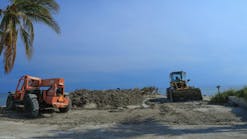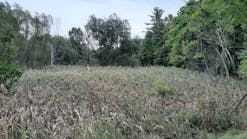Maitland, FL — This week, the St. Johns River Water Management District has completed a $2.7 million maintenance and improvement project to the nearly 20-year-old Lake Apopka Marsh Flow-Way, a constructed wetland designed to filter algae, suspended sediments and nutrients from the lake’s water.
The Marsh Flow-Way, located along the northwest shore of Lake Apopka and west of the Apopka-Beauclair Canal, is a recirculating system that filters about 40 percent of the lake’s volume each year. It began operation in November 2003.
To address a reduction in treatment efficiency, the District began maintenance of the Marsh Flow-Way in 2019 to re-level the wetland cells and reopen ditches that promote sheetflow conditions in the cells. The completed project restores the flow-way to its originally constructed condition and reestablishes its ability to efficiently filter suspended sediments and nutrients from Lake Apopka.
Overly enriched with nutrients, such as phosphorus and nitrogen, Lake Apopka has experienced persistent algal blooms for decades. The District’s restoration program works to reduce excessive nutrients in the lake by limiting the amount of nutrients and phosphorus entering the lake and removing accumulated phosphorous and sediments from the lake.
The Marsh Flow-Way system covers approximately 760 acres and contains four independent individual wetland cells, in addition to levees, canals and ditches. Prior to construction, the area had been farmed for decades, during which time many feet of organic soils had been lost. Now lake water flows by gravity from west to east through an individual cell before it is collected in the pump basin and lifted back up to the Apopka-Beauclair Canal. Most of the cleaner, treated water returns to Lake Apopka, while the remainder flows downstream toward Lake County Water Authority’s nutrient removal facility (NuRF) and Lake Beauclair.
The District’s multipronged approach to Lake Apopka water quality restoration has been “diet and exercise.” “Diet” has focused on reducing the amount of phosphorus entering the lake. The largest “diet” improvement occurred following the Legislature’s 1996 direction to the District to buy out the farms on the North Shore and restore the historic wetlands.
“Exercise” is removal of phosphorus already in the lake, which has included harvest of gizzard shad from the lake since 1993 and operating the Marsh Flow-Way since 2003 to continuously filter algae, suspended solids and associated nutrients.
“The Marsh Flow-Way was one of our earliest restoration projects to improve water quality in Lake Apopka,” said St. Johns River Water Management District Executive Director Dr. Ann Shortelle. “Today it is among a dozen projects at Lake Apopka to improve water quality and hasten the recovery of the lake’s submerged aquatic plants, a critical habitat for a sustainable sport fishery.”
Since the late 1980s, the District’s work at Lake Apopka has resulted in average lake phosphorus concentration reductions of 64% while water clarity has increased by 55%. The recovery of clearer water and return of sunlight to the lake’s bottom has caused the regrowth of submerged aquatic vegetation, missing for 50 years, and improved critical largemouth bass habitat.
Other current projects at Lake Apopka include a pay-for-performance project that uses an innovative technology to remove phosphorus from the lake’s water; multiple projects on the North Shore that improve water and phosphorus management capabilities so that the pumping back to the lake can be reduced; and projects to accelerate the recovery of aquatic plants in the lake.
Lake Apopka, located about 15 miles northwest of Orlando, is the headwaters of the Ocklawaha Chain of Lakes and is the fifth largest lake in Florida.






